The Catholic Church is composed of the Churches of Latin and Eastern rites that are in communion with the bishop of Rome. The national Conferences of the Catholic Bishops of the 27 countries participating in the European Union are represented in the COMECE, Commission of the Bishops' Conferences of the European Union, while the Council of Bishops’ Conferences of Europe (CCEE) is made up of 39 members representing the Catholic Church in 45 countries in the European continent.
The Catholic Church in Europe is represented by a population of 261,660,000 people, constituting 46% of the region’s Christian population (Pew Forum on Religion & Public Life, 2011). In 1910, 65% of world’s Catholics lived on the continent and they comprised 44% of Europe’s population. A century later, they number only 24% of the world’s Catholic population and 35% of the continent’s population. Among the 10 world countries harboring the most Catholics in 1910 were France, Italy, Spain, Poland, Germany and Czech Republic; but a century later, only Italy (-19%), France (-38%), Poland (+15%) and Spain (-25%) are still on the list (The Global Catholic Population, 2013). Europe is the only continent where the number of Catholics has not increased in the past few years.
Figures offer us a demography substantially changed in the last century and in the past decades, but are of course unable to express the changes in the way Catholics live their own faith: in most EU countries, over half of young adults are considered “nones,” as they do not to identify with any particular religion or denomination. Moreover, the changes that have occurred in the European religious landscape have had an impact on the role of the Catholic Church and on the perception of its presence in the national and European societies. This change has imposed some local challenges, while the global dimension acquired by the whole Church through clergy, orders and movements, and also by its charities, NGOs and other organizations, enlarges the perspective and complexity of the Church’s internal and external dynamics.
These changes create new religious and cultural proximities among peoples. Catholics now live in the same space (street, city, workplace) with believers of faiths that 30 or 20 years ago were considered “exotic,” or just living too far from Europe to be a matter of interest. The new proximities that Catholics experience in the European religious landscape must not be overestimated in terms of numbers and do not constitute a novel condition in European history, but certainly change the institutional and political framework especially in those countries —particularly in Southern and Eastern Europe — where Catholics used to be the major religious group and only recently became one of the largest minorities. Such a change in demographic and political positioning has effects not only in the way the Church projects itself in the public space, but also upon the perception of the role of the Church in public debate, and upon the role that Catholics can or want to play in the social and political context. More recently, in some countries, like Italy, Hungary or Poland, the Catholic constituency is an important pool of voters and support attuned with populist leaders and new forms of ethno-nationalism, which leverage fears of a loss of privileges deriving from the growth (or perceived growth) of other groups—usually Muslim groups. In other countries, like in Germany and France, the scandals of the sexual abuses perpetrated by members of the clergy is in the spotlight and time is needed to understand how the national Churches will be affected. Besides these contemporary pressures, the Catholic Church in most of the European countries plays an important role in the definition of educational policies (private schools funding and school vouchers, religious education at school), laws which involve ethical and bioethical questions (artificial intelligence, abortion, end of life), freedom of religion (which in most countries was significantly affected by the COVD19 pandemic), and sexuality.
Francesca Cadeddu
RESOURCES

Resources
https://www.ccee.eu (website of the Council of Bishops’ Conferences of Europe, CCEE)
https://www.comece.eu (website of the Commission of the Bishops' Conferences of the European Union, COMECE)
Annuarium Statisticum Ecclesiae 2019, Città del Vaticano, Libreria Editrice Vaticana, 2021
Pew Research Center, 5 Facts about Catholics (2018), in Europe https://www.pewresearch.org
INTERACTIVE INFOGRAPHICS
0 respect of international standards
-1 restriction of rights
-1 high gap between religious majority and minorities
No data shown for countries where the Church is the majority RO
0 respect of international standards
-1 restriction of rights
-1 high gap between religious majority and minorities
No data shown for countries where the Church is the majority RO

 MENU
MENU CLOSE
CLOSE

